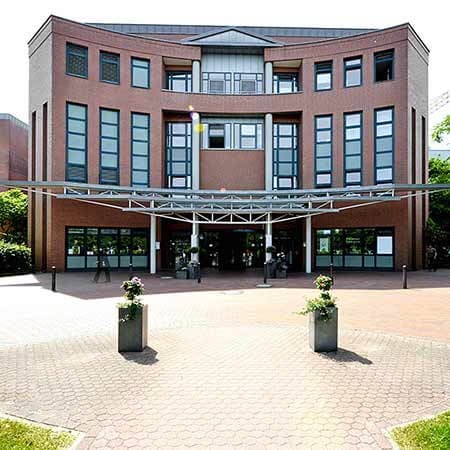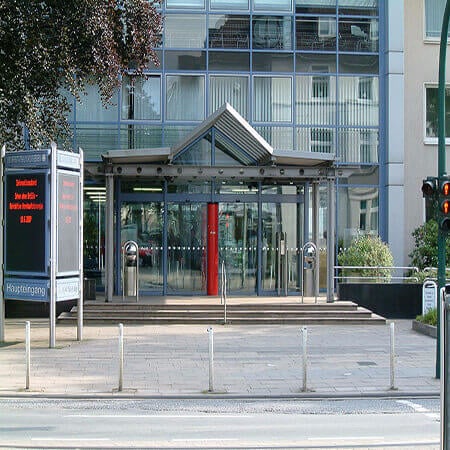According to population studies of 19 pediatric cardiac centers in Great Britain, Ireland, and Sweden, the total anomalous pulmonary venous connection was detected in 7 out of 100,000 newborns, accounting for 1.5-3% of the total incidence of congenital heart diseases.
Content
- Overview
- Diagnostics
- Treatment
- Where can I undergo anomalous pulmonary venous connection treatment in Germany?
- The cost of treatment in Germany with cardiac surgery
- How can I undergo anomalous pulmonary venous connection treatment in Germany?
Overview
Heart defects are the most common congenital cardiovascular malformations. Thanks to the modern medical services in the field of pediatric cardiac surgery, the survival rate is currently extremely high even in patients with complex heart defects.
During pregnancy, disruptions in the process of development of the cardiovascular system can lead to health abnormalities, i.e. congenital heart diseases. Lesions can involve structures inside the heart, such as the atrial or ventricular septum, heart valves, and vessels near the heart (e.g. aorta, pulmonary veins, pulmonary artery).
The total anomalous pulmonary venous connection is a congenital heart disease characterized by the absence of a physiological connection between the left atrium and the pulmonary veins.
The extreme rarity of detection of total anomalous pulmonary venous connection in patients over 18-20 years of age is due to high mortality in the 1st year of life in the natural course of this congenital heart disease. Up to 50% of newborns with total anomalous pulmonary venous connection die during the first 3 months of the postnatal period, and more than 80% die during the first year of life. Analysis of the natural course of total anomalous pulmonary venous connection showed that the average survival rate without treatment of the disease does not exceed 2 months of postnatal life. Mortality in the natural course of total anomalous pulmonary venous connection reaches 90% by the end of the 1st year of life. Without timely diagnosis making and treatment of this congenital heart disease, less than 7% of patients with total anomalous pulmonary venous connection survive to adolescence and older (more than 20 years) age; a few patients live up to 61-66 years.
Normally, oxygen-rich blood from the lungs flows through the pulmonary veins into the left atrium. From the left atrium, it flows into the left ventricle, from where it is distributed throughout the body. In newborns with total anomalous pulmonary venous connection, the pulmonary veins are connected to the right atrium, and not to the left. Therefore, a mixture of oxygenated and deoxygenated blood enters the right atrium, which usually receives only oxygen-poor blood from the body for pumping it into the lungs. The extra blood volume makes the heart work harder than normal. More importantly, blood from the pulmonary veins enters the right atrium through various pathways – above the heart, below the heart, or behind the back wall of the heart. These pathways can be narrowed or blocked, causing blood to flow back into the lungs increasing pressure in them and preventing them from functioning properly. Blood enters the left side of the heart only through the opening between the right and left atria.
When a total anomalous pulmonary venous connection occurs, hypoxia of organs and tissues develops. The right parts of the heart begin to increase in size due to excessive load on them. The consequences of such processes are heart failure and pulmonary hypertension.
It is essential to distinguish partial and total anomalous pulmonary venous connection. With a total, none of the four pulmonary veins enter the left atrium, with a partial – one or several veins still fall into it.
With total anomalous pulmonary venous connection, children have extremely severe health condition. In most cases, the first sign of congenital heart disease is rapid breathing, which is accompanied by symptoms of heart failure (edema, shortness of breath, enlarged liver, cough), as well as cyanosis of the skin.
Such children gain weight slowly, eat poorly, and have physical developmental delays. If the child survives, there will be high risks of frequent pneumonia and respiratory infections.
Diagnostics
Diagnostics of anomalous pulmonary venous connection is based on:
- Assessment of external signs, the presence of cyanosis
- Echocardiography results
- Chest X-ray data
- Cardiac catheterization with angiocardiography
- Auscultation of the heart
Auscultation reveals a systolic heart murmur with its maximum intensity in the second or third intercostal space to the left of the sternum. In some patients, a diastolic heart murmur is heard above the tricuspid valve. The II tone over the pulmonary artery is split regardless of the phases of respiration. In the presence of pulmonary hypertension, the pulmonary component of the II tone is enhanced.
When collecting anamnesis, it is recommended to ask about the presence of total anomalous pulmonary venous connection in the family and relatives, about the course of pregnancy and other health conditions of the child's mother.
It is recommended to ask about the shortness of breath, palpitations, fatigue that occurs after physical exertion, poor weight gain, and frequent infectious lung diseases.
However, an anomalous pulmonary venous connection may be asymptomatic. The phenomena of circulatory insufficiency may be insignificant and may include moderate weakness, sweating, cyanosis of the nasolabial area. Children often have an asthenic constitutional type with a noticeable pallor of the skin.
Treatment
The natural course of total anomalous pulmonary venous connection is unfavorable and 80% of children die in the first year of life. Patients with a partial anomalous pulmonary venous connection can live to 20-30 years. The causes of death of patients are severe heart failure or lung infections.
Treatment of the total anomalous pulmonary venous connection is surgical. Drug therapy is used only to stabilize the health condition of the newborns and prepare them for surgery. It is impossible to cure a patient with a total anomalous pulmonary venous connection without surgery. The key aim of the surgery in total anomalous pulmonary venous connection is the reconnection of abnormally located veins to the left atrium.
The treatment of anomalous pulmonary venous connection involves an open heart surgery with the connection of the patient to the heart-lung machine. The intervention is successful both in case of total anomalous pulmonary venous connection when all veins are attached to the right atrium, and in case of partial anomalous pulmonary venous connection. However, more complex types of anomalous pulmonary venous connections require the development of individual treatment protocols. The results of surgical correction of total anomalous pulmonary venous connection in the specialized cardiological departments are satisfactory.
The main goal of surgery for treatment of the total anomalous pulmonary venous connection is to create a communication between the common pulmonary vein collector and the left atrium, without deformation and narrowing of the anastomosis. There are several methods of surgical treatment that are used depending on the anatomical type of the anomalous pulmonary venous connection.
The general principles of radical correction of total anomalous pulmonary venous connection include creating an anastomosis between the pulmonary veins and the left atrium, ligating the pathological communication of the pulmonary veins with the venous vessels. After surgery, sick sinus syndrome may develop, as well as pulmonary hypertension associated with inadequate formation of outflow pathways from the pulmonary veins.
The results of patients’ examination are discussed by pediatric cardiologists and cardiac surgeons for further treatment planning. After collecting anamnesis and performing clinical examination, doctors refer patients to blood tests, ECG, X-ray and ultrasound examination. If more complex pathologies are detected, then doctors recommend additional diagnostic procedures before the surgery, such as a cardiac catheterization, computed tomography, and MRI. With severe cyanosis and a poor health condition of a small patient, a palliative operation may be performed at the initial stage. It is aimed at increasing the oxygen saturation of the blood by means of increasing the interatrial communication.
For planned surgery, the patient is admitted to the cardiology department the day before the surgery. On the evening before the operation, the surgeon and the anesthesiologist will discuss the upcoming surgery with the parents of a young patient or with an adult patient.
The choice of the surgical access to the heart depends on the individual peculiarities of the pathology. In most cases, the surgery is performed with a midline dissection of the sternum, which means that access to the heart is carried out through opening the chest. During the operation, a heart-lung machine is used. Typically, it is connected to the patient through both the vena cava and the aorta. In treating abnormalities of the aortic region, such as stenosis of the aortic isthmus, access can be made through an incision in the left chest wall.
The child is placed in special conditions in which the need for oxygen is reduced (comfortable temperature, emotional and physical rest). If necessary, heart failure is treated with the help of medications.
Depending on the existing pathology, surgical correction is performed on a temporarily stopped heart. After its completion the ribcage is connected with small wires.
After the surgery, patients are transferred to the intensive care unit of the pediatric cardiology department, where an experienced team of doctors and nurses provide patients with follow-up care and necessary medical services after the operation. If the systemic circulation is stable and the breathing tube can be removed, further treatment up to discharge will be performed by the pediatric cardiology team, in the usual ward.
Immediately after the surgery, parents are informed about how the procedure went.
The operation to correct the total anomalous pulmonary venous connection should be performed during the first months or even days after the birth of the child.
Sometimes severe manifestations of pathology may be life-threatening immediately after the birth of a child. They can be eliminated only with the help of emergency surgical intervention, which, unfortunately, is available only in the world's leading cardiac centers.
Where can I undergo anomalous pulmonary venous connection treatment in Germany?
Medical tourism is becoming more and more popular these days, as medicine in Germany often ensures a much better quality of cardiac surgery for the treatment of anomalous pulmonary venous connection.
The following hospitals show the best success rates in cardiac surgery in Germany:
- University Hospital Oldenburg
- University Hospital Essen
- University Hospital Ulm
- University Hospital Frankfurt am Main
- University Hospital Tuebingen
You can find more information about the European hospitals and the services they provide on the Booking Health website.
The cost of treatment in Germany with cardiac surgery
The prices in hospitals on the Booking Health website are relatively low. With Booking Health, you can undergo anomalous pulmonary venous connection treatment in Germany with heart surgery at an affordable price.
The cost of treatment in Germany varies, as the price depends on the hospital, the specifics of the disease, and the complexity of its treatment.
For example, the cost of treatment of total anomalous pulmonary venous connection in Germany starts at 31,770 EUR, while the cost of treatment of partial anomalous pulmonary venous connection in Germany starts at 32,111 EUR.
You might want to consider the prices of possible additional procedures and follow-up care. Therefore, the ultimate cost of treatment may differ from the initial price.
To find out the information on the overall cost of treatment in Germany, you may contact us by leaving the request on the Booking Health website.
How can I undergo anomalous pulmonary venous connection treatment in Germany?
It is not easy to self-organize any treatment abroad. It requires certain knowledge and expertise. Thus, it is safer, easier, and less stressful to use the services of a medical tourism agency.
As the largest and most transparent medical tourism agency in the world, Booking Health has up-to-date information about the treatment of anomalous pulmonary venous connection in the best European hospitals. We will help you select the right clinic taking into account your wishes for treatment.
We want to help you and take on all the troubles. You can be free of unnecessary stress, while Booking Health takes care of all organizational issues regarding the treatment in Germany. Our services are aimed at the safe and successful treatment of anomalous pulmonary venous connection.
Medical tourism can be easy! All you need to do is to leave a request on the Booking Health website, and our manager will contact you shortly.
Authors: Dr. Vadim Zhiliuk, Dr. Sergey Pashchenko














